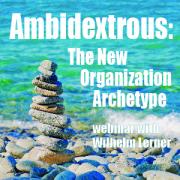Is your organization fast and creative on one hand, and productive and scale-driven on the other? In competitive markets, businesses need to be ambidextrous. But most companies excel in only one of those two dimensions. And even when they have strong capabilities in both, they are likely out of balance.
In this on-demand webinar with Cutter Consortium Senior Consultant Wilhelm Lerner, you’ll hear a case study on one organization’s successful journey to become ambidextrous. You’ll discover 6 major design dimensions (that break down into 72 specific capabilities) that make it possible to derive clear, actionable steps to improve the organization. You’ll learn why mastering the balance between the opposing imperatives of speed/creativity and scale/productivity systems is what makes ambidextrous organizations truly stand out.
In addition, Wilhelm Lerner walks you through an ambidextrous organization development canvas that helps you answer 3 critical questions:
- Where does my organization’s set of organizational capabilities currently stand?
- What organizational capabilities does my business need, considering both the strategic context and business requirements?
- What kind of organizational development path can I take to achieve a sound balance between scale/productivity and speed/creativity?
Discover why the ambidextrous organization has an advantage in the age of disruption, and how your organization can achieve that balance.



